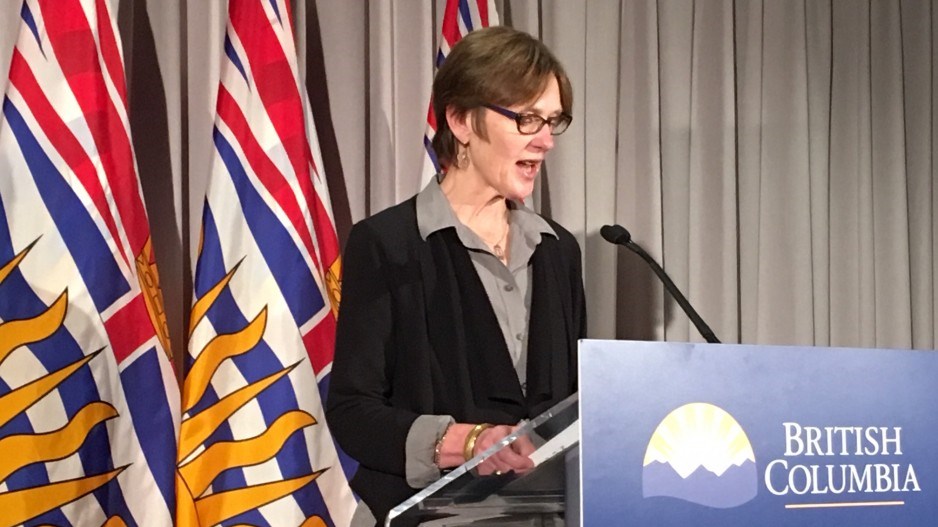The Lower Mainland could be waiting another two years until a plan to replace the ageing George Massey Tunnel gets tabled.
On Monday, the B.C. government released an independent report commissioned to re-examine the options to replace a tunnel that faces significant congestion, and is no longer seismically sound.
It found that the 10-lane bridge proposed by the BC Liberals cannot be justified in the face of other options. It recommended a smaller bridge or an immersive tube tunnel, along with the option to retrofit the existing tunnel.
Minister of Transportation and Infrastructure Claire Trevena says government will now consult with communities about the available options starting in January, and will release a new business case by the fall of 2020.
“Had the former government looked at the options fully and objectively, we wouldn’t be in this situation,” Trevena told reporters at the Pan Pacific Hotel in Vancouver on December 17.
“[This] extensive review confirms that a 10-lane bridge was the wrong project for the region, and flawed from the start.”
Reaction to the timeline has been swift, with many taking to social media to lament further delays.
The Greater Vancouver Board of Trade (GVBOT) tweeted it was disappointed by the announcement.
"It's estimated our region's population will grow by one million by 2041. We need to invest in a long-term solution that prepares us for this explosive growth over the next two decades," it tweeted, adding that the GVBOT has been a proponent of the 10-lane project.
The BC Liberals called the announcement a "band-aid" that will cost taxpayers more money, without fixing the problem.
The Wilderness Committee, Canada's largest citizen-funded wilderness protection group, celebrated the project's defeat.
The review found that a 10-lane bridge will likely exceed the region’s traffic needs through to 2045, and that an eight-lane replacement would capture 99% of future traffic volume. The key difference is two additional bus and high-occupancy vehicle lanes, which the report argued will not provide value for money.
To date, roughly $70 million in pre-planning work has been spent on the $3.5-billion 10-lane concept, which was cancelled last September.
That option is no longer being considered, and Trevena says government will now more thoroughly examine the costs, liveability and engineering requirements of a six-lane bridge, an eight-lane bridge and a tunnel.
The capital costs of those three options have not been examined. In the interim, Trevena announced government will undertake $40 million in upgrades in and around the tunnel between 2019-2020. These include measures to increase visibility in the tunnel, upgrading tunnel systems to meet current standards and resurfacing Highway 99 between Steveston Highway and the Highway 17 interchange.
Trevena also said government wanted to wait until after municipal elections so that it could consult with the region’s new leaders about the options they would like to see.
Three clear options to be considered
Two smaller bridges and a new tunnel will now be discussed and evaluated more thoroughly.
According to the technical review, a six-lane option would capture 87% of future traffic volumes in 2045 – an estimated 115,000 vehicles a day. Its net present value of travel time saved and operating cost benefits are 42% of those realized by the initial 10-lane bridge concept.
An eight-lane project could capture 91-99% of traffic volumes, and realize 50-95% of the 10-lane bridge's net present value, depending on whether the project includes the initial concept's highway improvements.
The report found significant justification to review the immersive tube tunnel model. One of the benefits of this option is reduced congestion as a result of trucking: trucks travelling up a bridge slow traffic down and result in the need for more lanes, whereas trucks descending into a tunnel can gain speed and exit at speed.
"An eight-lane crossing could be fine with a configuration that has the outer lane in each direction for mainly local traffic, as in one City of Richmond proposal. In contrast, using counterflow for five lanes in one direction would likely lead to congestion," wrote Jim Wright, acting chair of the Fraser Voices Association.
He found the report highlights "mainly promising," adding that a welcome feature would be an ongoing emphasis on transit, including a prompt influx of rapid bus.
Added considerations
The existing Massey Tunnel would likely need to remain operational during the construction of its replacement. It could also be retrofitted to serve as an additional transportation option for use alongside a bridge or separate tunnel.
A seismic upgrade to the tunnel could cost between $250-300 million – an amount the review notes could exceed the cost of a new structure that provides an equivalent level of transportation capacity.
Two bored tunnel options are explored in the report: twin four-lane tunnels, and twin two-lane tunnels plus upgrades to the existing one. Building the former is estimated to cost $1.8 billion, exclusive of highway upgrades, design, permitting, and project and construction management. Similarly, building the latter could cost an estimated $1.2 billion. Neither figures account for the decommissioning of, or upgrades to, the George Massey Tunnel. The accuracy range of the estimates is minus 20-50% and plus 30-100%.
The modelling in the review was also based on options with no tolls. If a tolled bridge were to be added, the report concluded first-year traffic would lead to a 17% increase in traffic on the Alex Fraser Bridge.
The review did not address how the various options might impact the Fraser River's shipping lane.




